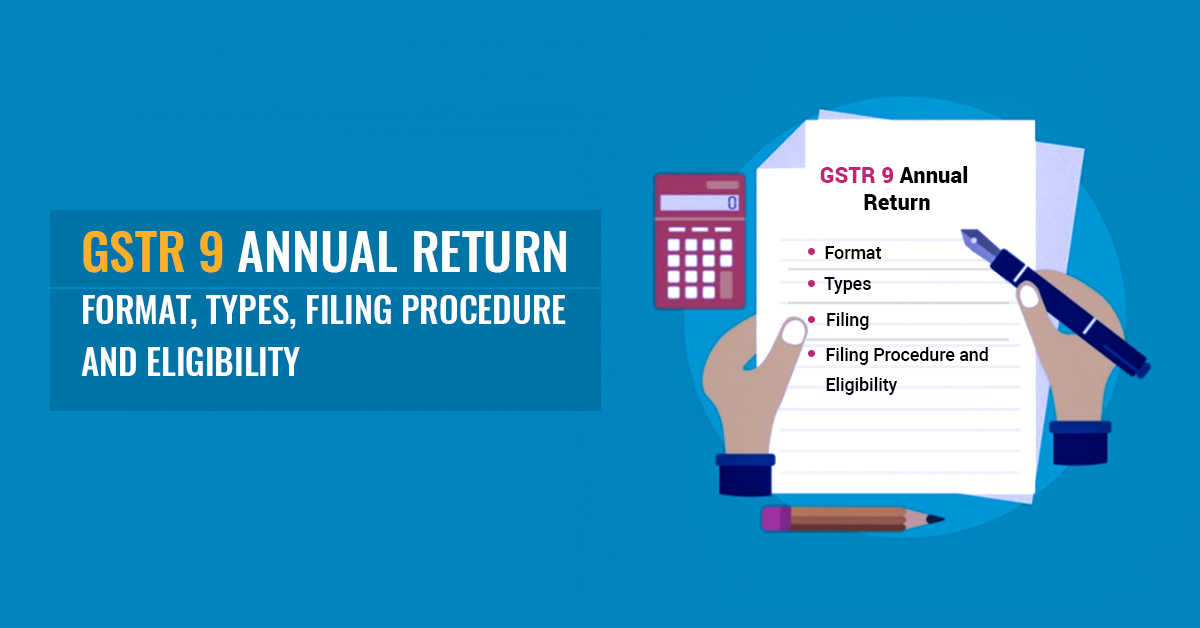The Govt, on 4th September 2018, announced GSTR 9 form which is an annual return for goods and services tax that will have to file by every taxpayer for the full year. The form of annual return is separate for the normal taxpayer (GSTR-9) and composition taxpayer (GSTR-9A). The new yearly return seems to be less difficult and simpler for taxpayers, however, a closer perusal of the format appears there might be some areas of conflict.
Contents
What is GSTR 9 or Annual GST Return
GSTR 9 is one of GST (Goods and Services Tax) Return forms. It is a GST annual return which is required to be filed by registered taxpayers every year. It contains consolidated details of the supplies (purchases and sales) made and the tax paid by a registered taxpayer during that year.
Approved key features for GST annual return form:
The GST annual return form for normal taxpayers divided into 6 parts with 19 tables which include details about to inward supplies, outward supplies, ITC reversed, ITC availed, ineligible ITC, HSN summary of inward supplies, HSN summary of outward supplies and particulars of demand and refund etc.
Majority of the data to be filled in the above tables depend on data fill in GSTR-3B and GSTR-1 for the particular period and thusly, some of it also gets auto-populated.
GSTR 9 Types under GST
There are 4 different types of GSTR-9 returns which will be filed according to the following rules:
GSTR-9A will be filed by the taxpayers who are registered under the GST composition scheme.
GSTR 9B is to be filed by e-commerce companies operating in India who have already filed GSTR-8 for the financial year.
GSTR 9C will be filed by the taxpayers who have reported an annual turnover of over 2 crore rupees. The GSTR 9C filers are also liable to have their accounts audited. A copy of the accounts audit along with a reconciliation statement of the tax paid and tax due is needed to be attached with this return.
GSTR 9 will be filed by all other (regular) taxpayers who have not filed any of the above forms and are regularly filing their GSTR-1, 2 and 3 returns.
GSTR 9 Eligibility – Who will file it?
GSTR 9 is required to be filed annually by all the GST registered taxpayers (regular and composite), in addition to registered e-commerce operators and those businesses whose annual income is over 2 crore rupees. (As mentioned above).
GSTR 9 is not to be filed by the following entities:
- Casual (occasional) taxable entities
- Non-resident taxable persons
- Input service distributors
- TDS payers
GSTR 9 Due Date – When to file it?
GSTR 9 is an annual GST return which will be filed on or before the 31st of December of the following financial year.
- Extended GSTR-9 deadline for FY 2017-18 – 31st January 2020* (Check Notification)
- GSTR-9 deadline for FY 2018-19 – 31st March 2020*
Penalty for late filing of GSTR-9
If a taxpayer does not file his GSTR-9 return by the deadline, as mentioned above, he/she has to pay a penalty of INR 200 per day (INR 100/day in CGST + INR 100/day in SGST), subjected to a maximum penalty of not more than a quarter percent (¼%) of the annual turnover of the person in the respective State.
In addition to the late fee, the taxpayers will also have to pay an interest at the rate of 18% per year on their outstanding tax amount.
GSTR 9 Format and Filing Procedure
GSTR 9 format has the following sections.
1. GSTIN
This section will contain the 15-digit GSTIN (Goods and Service Tax Identification Number) of the taxpayer allocated to them at the time of the registration.
2. Legal name of the business (or registered person)
Name of the registered taxpayer will auto-populate based on the GSTIN details.
2C. Whether liable to Statutory audit
For those companies or HUF whose annual turnover is over INR 1 crore, this option is compulsory.
3. Date of Statutory Audit
For those who are liable for a statutory audit, the date of audit should be mentioned here.
4. Auditors
The field would contain the name/s of the auditors who performed the audit of the accounts of the taxpayer.
5. Details of Expenditure
Details of the purchases (of goods and services) made during the financial year along with the HSN/SAC codes as applicable and the tax liability for such purchases. (These details can be found in GSTR 2 of the respective period).
(a) Total value of purchases on which ITC availed (inter-state): The total value of purchases made inter-state on which ITC was availed by the taxpayer during the financial year.
(b) Total value of purchases on which ITC availed (intra-State): The total value of purchases made intra-state on which ITC was availed by the taxpayer during the financial year.
(c) Total value of purchases on which ITC availed (Imports): The total value of imports on which ITC was availed by the taxpayer during the financial year.
(d) Other Purchases on which no ITC availed: The value of purchases on which ITC was not availed.
(e) Sales Return: Details of purchased items which the taxpayer returned back, if any.
(f) Other Expenditure (Expenditure other than purchases): Any other purchases (expenses) made during the year.
6. Details of Income
This head will contain the details of all supplies (sales) made by the taxpayer during that financial year. (You can take these details from your monthly GSTR-1 returns). It has the following subheads:
(a) Total value of supplies on which GST paid (inter-State Supplies): Mention the total value of inter-state supplies (sales) on which GST was paid during this period.
(b) Total value of supplies on which GST Paid (intraState Supplies): Mention the total value of intra-state supplies (sales) on which GST was paid during this period.
(c) Total value of supplies on which GST Paid (Exports): Mention the total value of exports on which GST was paid during this period.
(d) Total value of supplies on which no GST Paid (Exports): Mention the total value of export on which GST was not paid.
(e) Value of Other Supplies on which no GST paid: Mention the total value of supplies (sales) other than exports on which GST was not paid during this period.
(f) Purchase Returns: Details of items which were returned back by the buyers, if any.
(g) Other Income (Income other than from supplies): Any other income generated during the year.
7. Return Reconciliation Statement
The system will automatically calculate the pending tax liability based on the details provided by you in this return. The details of tax payable, difference, interest and penalty (if any) will auto-populate in this head.
8. Other
The detail of other payable tax or refunds (if any) will reflect in this head based on the details provided above.
9. Profit as per the Profit and Loss Statement
This section will mention the details of the gross profit, profit after tax and net profit earned by the taxpayer during the year.
At the end of the document, the taxpayer will have to provide his/her digital signature to authenticate the information provided in the return.
Revisions in GSTR-9
GSTR-9 form, just like all other GSTR forms, cannot be revised after it is submitted. Any errors or mistakes in the form can be revised while filing monthly tax returns.







In GSTR 2 A ( 2017-18 ) it is seen that some invoices which I did not purchase but loaded by my Principal . What is to be done . In some months they did no load the Invoices which I have purchased. What to do in both the cases.
Please read here about GSTR 2A